Wildlife at Bloedel: Amphibians
Visitors to Bloedel Reserve are likely to encounter various kinds of wildlife. Guests are most almost guaranteed to spot deer and ducks. Eagles, owls, and coyotes are present, but somewhat more evasive. The truly lucky visitor may even see a river otter. But Bloedel Reserve is also home to a variety of amphibians, particularly frogs and salamanders. Though these amphibians are quite common at the Reserve, guests may not see them because they are small and shy, tending to hide away from curious eyes.
Frogs vs. Salamanders
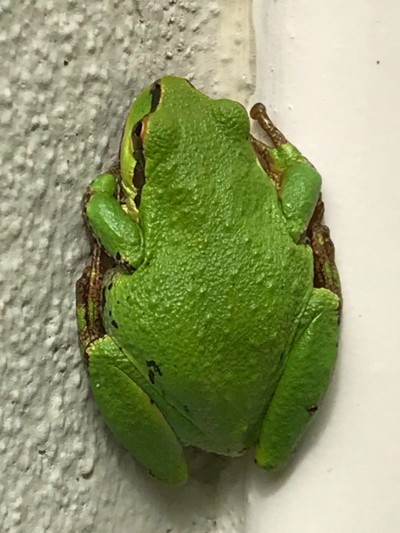
The Pacific Tree Frog
The most obvious visual differences between frogs and salamanders are the frog’s lack of a tail and the salamander’s superficial resemblance to a “shiny” lizard. Most visitors encountering amphibians at Bloedel will see frogs more often than salamanders. This is because salamanders are more reclusive than frogs, preferring to hide in water or under debris or plants.
Curious visitors who look closely around the Bloedel ponds in the spring will also see amphibian egg masses. The individual eggs of both frogs and salamanders consist of a clear jellylike outer layer with a darker embryo inside. These eggs clump together in groups ranging from just a few eggs to dozens of eggs in a mass. It is possible to distinguish between frog and salamander egg masses. The salamander egg masses will be surrounded by an additional protective layer of clear jelly that is absent from frog egg masses.
Bloedel Amphibian Etiquette
At Bloedel Reserve, we strive to protect the frogs and salamanders. In the spring, when we are removing debris and weeds from ponds, we look for tadpoles and egg masses and carefully return them to the water if they are accidentally removed. Gardeners cleaning up leaves or other plant debris also watch out for hidden frogs and salamanders and relocate them underneath nearby plants where they can be safe.
If you encounter frogs or salamanders or their eggs, please just look, but don’t touch. If you find them on a road or trail or some place unsafe, you are welcome to gently encourage them to move on.
Frog Finds
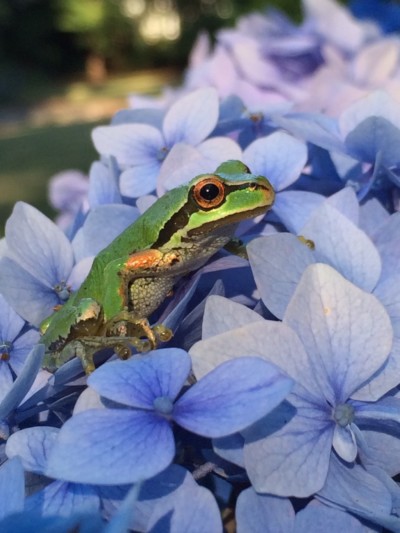
The Pacific Tree Frog
The Pacific Tree Frog (Pseudacris regilla) is the most common amphibian at the Reserve. Individual frogs are generally from 2 to 5 centimeters long. They are usually green with dark splotches, but grey to reddish brown variants may be found also. Despite its name, this species is usually found on the ground or on small plants and shrubs rather than on trees. These frogs prefer forested areas near small ponds where they can lay their eggs. Guests may see them almost anywhere on the grounds, often hanging out on a shrub or rock.
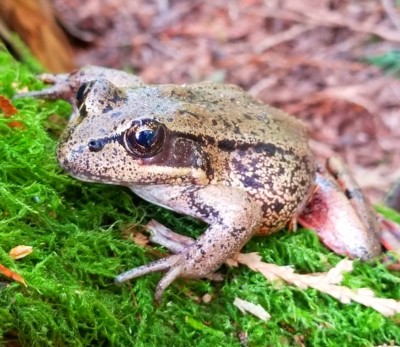
The Cascades Frog
Slightly less common at the Reserve is the larger Cascades Frog (Rana cascadae). These frogs are generally 4 to 8 centimeters long and are brownish with black spots on their backs. The pattern of black spots can be quite variable from frog to frog, but the white line running from their jaws back to their shoulders helps distinguish them from other frog species. The Cascades Frog prefers to hang out near ponds, but may venture further afield in wet weather. Look for them in the same locations where you might find the Pacific Tree Frog.
Slippery Salamanders
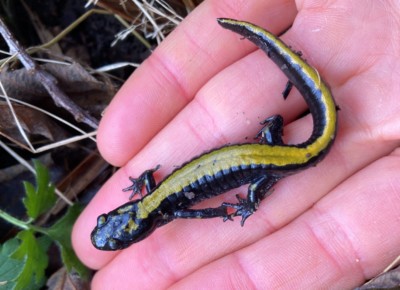
The Long-Toed Salamander
We think that the Long-toed Salamander (Ambystoma macrodactylum) is the most common salamander species at Bloedel Reserve, but we are not sure. We see this shy salamander much less frequently than we see frogs, so it’s hard to tell exactly how many there are. This salamander species is very easy to distinguish from the other two species known at the Reserve. It has dark skin with a very obvious yellow stripe running down its back. These salamanders range from 4 to 9 centimeters long. Their common name comes from the fact that they have one toe longer than the rest of the toes on each of their hind feet. We often find the Long-toed Salamander hiding under moist vegetation and debris.
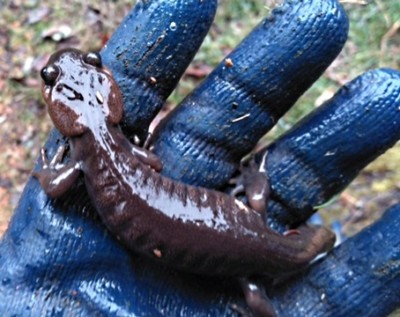
The Northwestern Salamander
The slightly larger Northwestern Salamander (Ambystoma gracile) is found in similar locations as the Long-toed Salamander. Measuring 7 to 13 centimeters, it is generally browner than the Long-toed Salamander and it lacks the yellow stripe. This species is mildly poisonous, exuding its poison from glands on its head and tail. Its egg masses are readily distinguishable from other amphibian species due to the algae growing inside the eggs that gives them a greenish cast.
The Elusive Newt
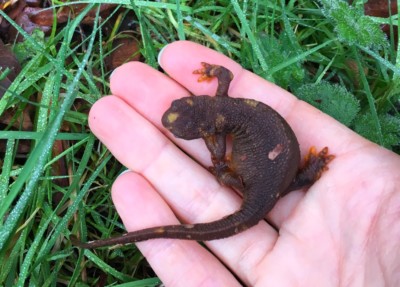
The Rough-Skinned Newt
We know there is a third salamander species found on Bainbridge Island. But so far, we haven’t spotted it at Bloedel Reserve — the Rough-skinned Newt (Taricha granulosa). Newts are salamanders that spend most or all of their adult lives in the water. The other two Bloedel salamanders are terrestrial as adults, living on land except during the breeding season.
The Rough-skinned Newt can be quite large, ranging from 15 to 22 centimeters. It usually has bumpy brown skin and with an underside that can be yellow to red. This newt prefers slow-moving water, but it can sometimes be found on land under rocks and logs. If you see one at Bloedel, take a photo and let us know, but please don’t touch. This species can be quite poisonous, causing mild skin irritation to those who touch it and paralysis and even death when ingested. (Of course, we sure hope you’re not eating any salamanders at Bloedel Reserve. But definitely leave this one alone!)
Written by Grounds & Horticulture staff member Darren Strenge, with photos from staff and crew members Kristin Dalhoff, Erin Hill, Sina Irving, Ken Little, Gunda Lunde and Tobin Tripp.
SIGN UP FOR OUR ENEWSLETTER
Stay up to date on all of the events and activities taking place at Bloedel Reserve.

